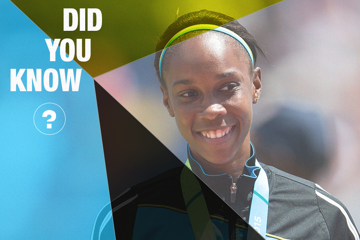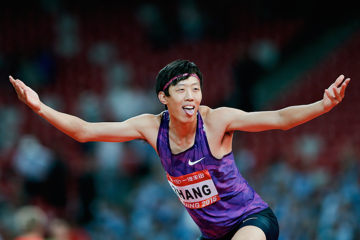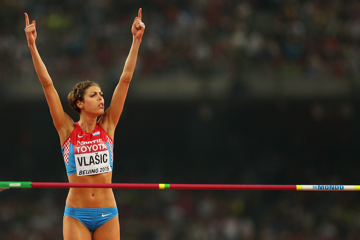St Lucia High Jump
St Lucia (population approx. 180,000) is an island famed for the Pitons – two stunning mountainous volcanic spires that rise almost vertically more than 2000 feet on the edge of the ocean. Yet on August 29 the Pitons were put in the shade by the island's Levern Spencer and Jeannelle Scheper, who both qualified for the World Championship high jump final in Beijing. Here are six reasons the pair were able to achieve the feat.
1. Gene pool
Without good genes you are unlikely to flourish as a top quality athlete, and both of St Lucia's high jump queens come from good stock. Jeannelle Scheper’s parents hail from Barbados; her mother, Sheryl, is “very into fitness” and her dad, Gerrit, is an ex-volleyball player. Her uncle, Barry, was a triple jumper and took up a US scholarship.
Levern Spencer, who is 11 years Scheper’s senior, also has athletic parents. Donald, her father, played football, while her mum, Anne Marie, is an occasional competitor in age-group sprint competitions.
“My mum and dad both did athletics at high school. It runs in the family,” Spencer says.
2. Inspiration
There is little doubt Spencer, 31, acted as a huge inspiration for Scheper, 20. Spencer boasts a proud 14-year international career that includes world youth bronze (’01), PanAm gold (’15) and bronze (’07) medals, a pair of Commonwealth bronze medals (’10 and ’14) and six world champs appearances.
Scheper first competed against her countrywoman aged 13 at the Hampton Games in Trinidad, and clearly recalls the experience.
“Levern was a big name at home and I was terrified of her,” she says of the awe in which she held Spencer. “I was so quiet, but I remember that competition she spoke to me and gave me a few pointers.
“She is quiet and shy but I have since found out she is such an awesome teammate to have. Levern is older than me but to some extent she inspired me to specialise in high jump.”
Spencer clears at this year's PanAm Games, where she won gold with 1.94m – her best jump of the season
3. Talent spotters
While cricket and football are the two primary sporting passions on St Lucia, athletics is also a big deal. It was the smart thinking of their respective high school PE teachers that set Spencer and Scheper on their track and field path
“The physical education teachers do a very good job at picking people out to do specific events,” explains Scheper. “Cuthbert Modeste picked me out at school sports and contacted my mum to ask if he could start training me.”
For Spencer, it was her high school teacher who advised she take part in the high jump – it proved an inspired decision. Aged 14, and in the first serious competition of her burgeoning career, she broke the St Lucian record with a mark of 1.69m.
Some 17 years on she is still the owner of that record (which now stands at 1.98m). “[The high school teacher] saw the ability and potential in me. I had no idea setting the record that day would take me this far.”
4. Sound coaching
We were disappointed to learn that St Lucian people are not renowned for being excessively tall and thin – the typical shape of world-class high jumper. Although Scheper and Spencer both fit the bill, their frames cannot be described as typically St Lucian (although Darren Sammy, the star international cricketer who hails from the island, stands at around 6ft 6ins). The pair benefited from a good early coaching, which both attribute to their emergence on the pro circuit.
Scheper believes that the coaches on the island are generally more experienced in the high jump; she worked with Cuban coach Victoria Despaigne in her younger days. Spencer, meanwhile, fully “appreciates” the work she did during her foundation years with Gregory Lubin. “If it wasn’t for him I would never have got to where I have today,” she remarks.
Darwin Edwards, another of St Lucia’s outstanding athletes of recent times (PB 2.31m), reached the 2011 world champs high jump final. Elsewhere, Makeba Alcide, St Lucia’s heptathlon representative in the 2013 world champs, says her favourite event is – surprise, surprise – the high jump. They’re coaching them right.
Nobody. Move. A. Muscle........... OK we good
5. American development
Both Spencer and Scheper are open about the fact that moves to the USA helped further their careers. The relative close proximity between their Caribbean island and the US mainland makes the journey a well-trodden one for the sporting talent of St Lucia.
Spencer took off for the US 11 years ago to study at the University of Georgia. Scheper took up a scholarship at the age of just 16 at the University of South Carolina.
“We built on what we learned in St Lucia,” says Spencer. “There is no special programme in St Lucia and there is still work to be done to train the younger athletes to compete on a world level.”
For Scheper, the move to the US crystallised her decision to pursue high jump. “I was recruited as a heptathlete but my mechanics for long jump and hurdling were not very good. They decided as I was just 16 at the time not to run me into the ground and focus on high jump, which was the right decision.”
6. Raising the bar
Spencer struck gold at the Pan American Games in Toronto in July before finishing 12th in Beijing. Scheper has just enjoyed the best year of her career, setting a PB of 1.96m to earn gold at the SEC Outdoor Championships in May and snaring the NCCA title the following month, going on to finish seventh in Beijing.
Both are keen to leave a legacy so St Lucian athletics continues to grow in future.
“I would like a platform of how to give back,” says South Carolina-based Scheper. “I’m working on a few different ideas on how I could impact on the country in athletics. I am thinking of organising a jumps clinic with my coach, Delethea Quarles, in St Lucia.”
For Spencer, the desire to give back is just as strong.
“We do have young athletes coming through but the goal now is to develop more international athletes, put on more clinics and get more people involved,” she adds. “I would like to keep the younger athletes motivated and let them know the benefits of track and field. There is still more work to be done.”








